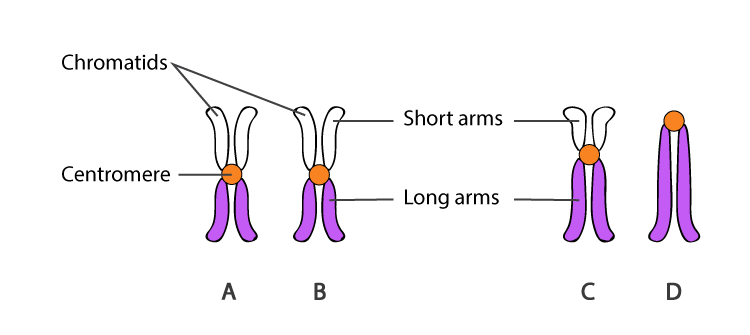A centromere is a constricted region of DNA or a structure in a chromosome, which plays an essential role in the segregation of chromosomes during the process of the cell cycle in eukaryotic cells.
Let’s learn more about the centromere along with its structure, functions and different types of the centromere.
Table of Contents
- What are Centromeres?
- Structure of Centromeres
- Functions of Centromeres
- Types of Centromeres
- Point Centromeres
- Regional Centromeres
What are Centromeres
Centromeres can be defined as the compressed region or a part of elongated chromosomes. It is the specialized DNA sequence in the chromosomes that links or holds together the pair of sister chromatids. The centromeres are also involved in separating the chromosome into a short arm (p) and a long arm (q).
As per the name, centromeres are not located exactly in the centre but are located at the end of chromosomes. This organelle is also referred to as the chromosome’s arms as they are present on either side of the centromere.
Also Refer: Difference between Chromosome and Chromatid
Structure of Centromeres

According to the examination of centromeres under the light microscope, it is generally believed that the main component of the centromere is the kinetochore and DNA-associated proteins. Centromeres are densely packed with the heterogeneous domain capped by the trilaminar kinetochore. The DNA of the centromeres is normally in a heterochromatin state, which is required for the attachment of sister chromatids mediated by the cohesin complex and also for the separation during anaphase.
Functions of Centromeres
- The centromeres are the point of attachment of the kinetochore. The main functions include the attachment of sister chromatids, and it is the site for the attachment of spindle fibre.
- Centromeres help in the proper alignment and segregation of the chromosomes during the process of cell division in eukaryotic cells.
- Centromeres play an important part in the production of a new cell. When the chromosomes are copied, these centromere serves as a binding site for the two replicated chromosomes, which are known as sister chromatids.
- Centromeres are also involved in the sister chromatid adhesion and separation, chromosome movement, microtubule attachment, the establishment of heterochromatin and mitotic checkpoint control.
- Centromeres also function as sophisticated signal processing centres, which are involved in the regulation of cell cycle progression.
Also Read: Cell Cycle
Types of Centromeres
Broadly speaking, there are two main types of centromeres.
Point Centromeres
These are centromeres where the mitotic spindle fibres are attracted to specific sequences of DNA. In this case, the cell proteins bind to these particular DNA sequences and form the foundation for the binding of the mitotic spindle fibres.
Regional Centromeres
Humans and most eukaryotic cells have regional centromeres.
These centromeres are determined during the mitotic spindle binding by a combination of characteristics working together to signal the location of a centromere and not by a precise sequence of DNA.
There are other types of centromere and this classification is mainly based on the location of the centromere on the chromosomes, which includes – Metacentric, Submetacentric, Acrocentric, and Telocentric.
Stay tuned with BYJU’S to learn more in detail about the Centromeres, their types, structure, functions, their significance and other related topics at BYJU’S Biology.
Frequently Asked Questions
What is a centromere?
How does the position of the centromere form the basis of the classification of chromosomes?
Chromosomes are divided into four types based on the position of the centromere.
- Metacentric chromosome: The chromosomes in which the centromere is present in the middle divide the chromosome into two equal arms.
- Sub-metacentric chromosome: The chromosome in which the centromere is slightly away from the middle region is a sub-metacentric chromosome. In this, one arm is slightly longer than the other.
- Acrocentric chromosome: The chromosome in which the centromere is located close to one of the terminal ends is known as an acrocentric chromosome. In this, one arm is extremely long and the other is extremely short.
- Telocentric chromosome: The chromosome in which the centromere is located at one of the terminal ends is known as a telocentric chromosome.
Write the functions of the centromere.
Functions of centromere are as follows:
The centromere is the region which separates a chromatid into two arms. It is the site of the duplicated chromosome around which the kinetochore is present to attach to the microtubules of the spindle fibres. It helps in the proper segregation of chromosomes.
